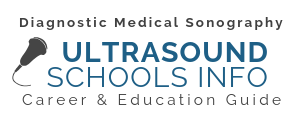Ultrasound is a non-invasive imaging technique that employs sound wave technology to examine organs and other interior body parts for diagnostic, monitoring and therapeutic purposes. An ultrasound technician, also referred to as a diagnostic medical sonographer, is a vital member of a healthcare team, whether it be at a hospital, outpatient facility, doctor’s office or medical laboratory.
Sonographers must have at least an Associate of Science in Diagnostic Medical Sonography, and an important part of that degree program is clinical training.
What is Clinical Training?
Clinical training (commonly referred to as just clinical) is courses that are taken outside of the classroom environment. This is the critical hands-on training portion of your education. Under the direct supervision of your instructor, preceptor, or another on-site sonographer, you will get practice scanning patients in a clinical environment such as a hospital or imaging center.
The training program allows students to learn the theory and practice of sonography in the classroom, laboratory and during clinical rotations. There is also ultrasound training in the form of professional development so that practicing sonographers can upgrade their skills and further specialize.
Choosing Your Sonography Program
Arguably one of the most important things to consider when researching schools is the accreditation of the ultrasound program. In order to be accredited, a school or program must pass a review by an independent accrediting agency. If they are able to pass that review, it’s a testament to the quality of the education that the school is providing.
For diagnostic medical sonography, the primary accrediting agency is the Commission on Accreditation of Allied Health Education Programs (CAAHEP). Graduating from a program that has been accredited by the CAAHEP is desirable or even required by many employers, and it will qualify you to sit for your credentialing exams.
“CAAHEP-accredited programs must have a one-to-one staff to student ratio in clinical education situations. This means that if there are three students at a clinical site, there must be three supervising sonographers.” notes Sam Callis in her book, Diagnostic Medical Sonography – The Definitive Guide to Planning Your Career.
Learn From the Best!
Candice Sellers, B.C., RDMS
Candice Sellers, B.S., RDMS, was awarded top clinical student in her class.
“There are many objectives that a student should master during their clinical rotations. The three key things that helped me to have an exceptional clinical experience were being proactive, having a team player mindset, and an eagerness to learn.”
Obtaining Your Credentials
It is likely that any potential employer will require you to have your RDMS credentials. Obtaining your degree from a CAAHEP accredited program will qualify you to sit for their Sonography Principals and Instrumentation (SPI) exam as well as a specialty exam.
Coursework Expectations
In addition to your clinical coursework, there will be in-classroom training that will include classes such as:
- Anatomy and Physiology
- Patient Care in Diagnostic Sonography
- Ultrasound Imaging
- Ultrasound Case Studies
- Clinical Pathology
Ultrasound technicians also learn about patient care, communications, physics (particularly as it pertains to sound wave technology), health law and other relevant disciplines.
FAQ
Are There Online Sonography Training Programs?

Normally as part of a degree or certificate program, the ultrasound technician training must be done in person, particularly when it comes to using ultrasound equipment. However, if a student has already done all of the required clinical hours, he or she may have the option to complete some ultrasound courses online.
For example, if you have already completed an Associates degree in ultrasound and wish to take Bachelor degree completion courses, some schools will offers these online. You can request information from various colleges and universities to find out which offer ultrasound training programs partially or fully online.
Additionally, if you wish to take professional development courses (i.e. in order to maintain ARDMS or other credentials or to further specialize and upgrade your career), several organizations offer ultrasound courses online or by correspondence, such as the Society of Diagnostic Medical Sonography (SDMS), the American Society of Radiologic Technologists (ASRT) and the Institute for Advanced Medical Education (IAME).
Online training resources such as those provided by the MDCT provide real life e-learning case studies that can be a supplement to your educational program.The goal of MDCT.com.au is “…to provide FREE education to ALL with more than 20,000 cases online…See (their) latest conferences as (they) have a proven track record with more than 3000 attendees to date”.
Are Internships Available as Part of a Training Program?
As part of a sonography degree or certificate program, there is almost always at least one clinical internship included in the ultrasound training; in many cases, depending on the length of the educational program, you will have the opportunity to complete two or more internships to gain experience in various work settings and specialties of ultrasound. Clinical internships are an essential component of ultrasound tech training as individuals finally get to put all they’ve learned into practice.
What are the Next Steps?
Once you complete an Associates or certificate program, you will have gained the experience and skills that can help you gain entry-level employment in the field of sonography. It’s a good idea to apply for ARDMS and other certifications as soon as possible as this will make you a more competitive job candidate and in some cases employers require it.
Look for employment at hospitals – according to the Bureau of Labor Statistics, the majority of diagnostic medical sonographers work in hospitals – and also physicians’ offices, diagnostic or medical laboratories, outpatient centers and other healthcare facilities.
If you’ve graduated with higher levels of education and/or already have experience working as an ultrasound technician, it’s time to update your resume and add all your recent ultrasound training. Depending on the training you received, you may be eligible to apply for managerial, department head or consulting positions or for more specialized jobs, such as echocardiographer or neurosonographer positions.



